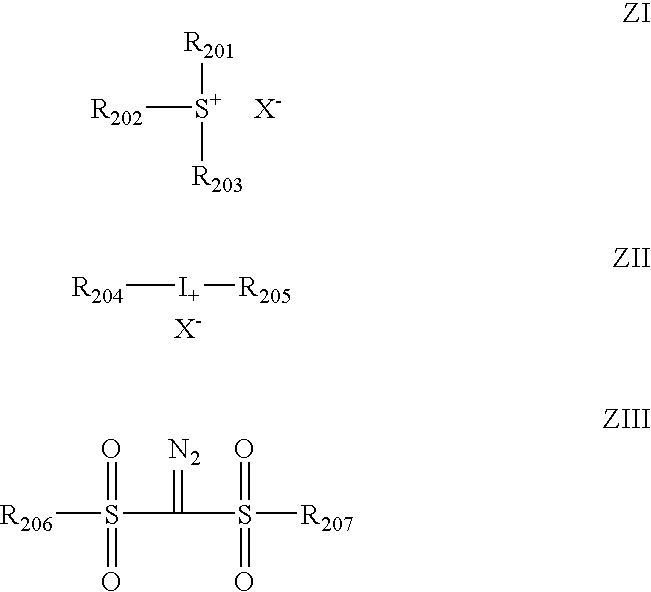Positive photosensitive composition and method of pattern formation with the same
a composition and photosensitive technology, applied in the field of positive photosensitive composition and pattern formation method with the same, can solve the problems of pattern-forming ability, pattern-forming ability, and insufficient chemical amplification type system, and achieve the effect of improving line edge roughness and pattern falling, and excellent development defects
- Summary
- Abstract
- Description
- Claims
- Application Information
AI Technical Summary
Benefits of technology
Problems solved by technology
Method used
Image
Examples
synthesis example 1
Synthesis of Monomer (A)
[0327] In 150 mL of toluene were dissolved 9.8 g of hydroxydiamantane, 3.7 g of methacrylic anhydride, and 0.5 g of concentrated sulfuric acid. This mixture was reacted for 2 hours under refluxing conditions. The resultant liquid reaction mixture was washed with an aqueous sodium hydrogen carbonate solution and subsequently with distilled water, dried with anhydrous sodium sulfate, and then concentrated to thereby obtain a crude reaction product. This product was purified by column chromatography. As a result, monomer (A) was obtained in an amount of 6.3 g.
synthesis example 2
Synthesis of Monomer (B)
[0328] To 160 mL of bromine cooled at −7° C. was gradually added 40 g of diamantane while keeping the temperature of the resultant liquid reaction mixture at 10-3° C. or lower. Thereafter, 2.16 g of aluminum bromide was gradually added to the reaction mixture while keeping the temperature of the mixture at 0° C. or lower. The resultant liquid reaction mixture was stirred at −7° C. for 30 minutes and then slowly poured into a solution composed of 500 g of sodium sulfite, 160 g of sodium hydroxide, and 3 L of water. The resultant precipitate was taken out by filtration and washed with acetonitrile. Thus, 63 g of dibromodiamantane was obtained.
[0329] To 20 g of the dibromodiamantane was slowly added 80 mL of concentrated nitric acid. This mixture was heated to 70° C. and reacted for 30 minutes. The resultant liquid reaction mixture was poured into 300 mL of water. Thereto was added 72-g sodium hydroxide / 500-mL water to make the mixture alkaline. The resultant ...
synthesis example 3
Synthesis of Resin (RA-1) (Dropping Polymerization)
[0331] In a nitrogen stream, 5.1 g of propylene glycol monomethyl ether acetate and 3.4 g of propylene glycol monomethyl ether were introduced into a three-necked flask. The contents were heated to 80° C. Thereto was added dropwise over 6 hours a solution prepared by dissolving 2.7 g of monomer (A), 4.7 g of 3-hydroxyadamantane methacrylate, 7.0 g of 2-methyl-2-adamantyl methacrylate, 6.8 g of γ-butyrolactone methacrylate, and 4 mol % initiator V-601 (manufactured by Wako Pure Chemical) based on the monomers in 46 g of propylene glycol monomethyl ether acetate and 30.7 g of propylene glycol monomethyl ether. After completion of the dropwise addition, the reaction mixture was further reacted at 80° C. for 2 hours. The resultant liquid reaction mixture was allowed to cool and then poured into 720-mL hexane / 80-mL ethyl acetate. The powder precipitated was taken out by filtration and dried. As a result, resin (RA-1) was obtained in an ...
PUM
 Login to View More
Login to View More Abstract
Description
Claims
Application Information
 Login to View More
Login to View More - R&D
- Intellectual Property
- Life Sciences
- Materials
- Tech Scout
- Unparalleled Data Quality
- Higher Quality Content
- 60% Fewer Hallucinations
Browse by: Latest US Patents, China's latest patents, Technical Efficacy Thesaurus, Application Domain, Technology Topic, Popular Technical Reports.
© 2025 PatSnap. All rights reserved.Legal|Privacy policy|Modern Slavery Act Transparency Statement|Sitemap|About US| Contact US: help@patsnap.com



